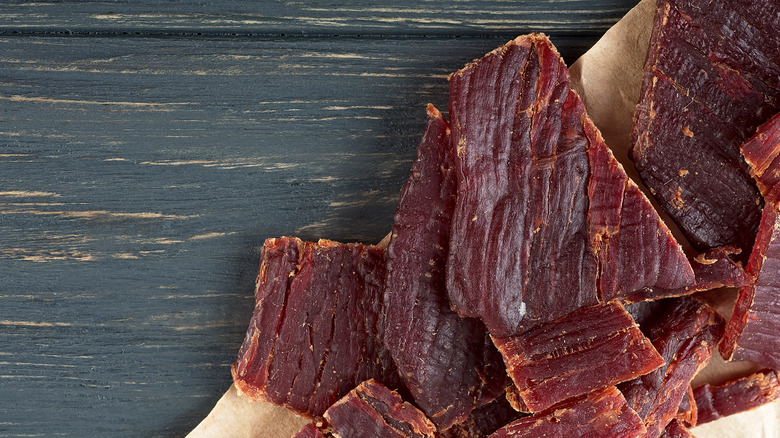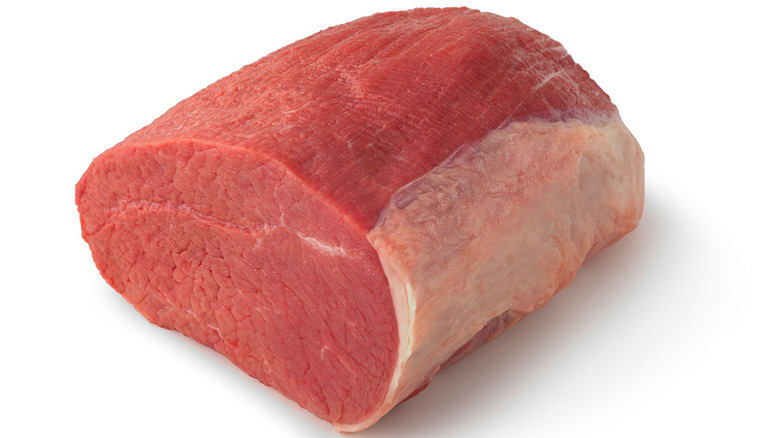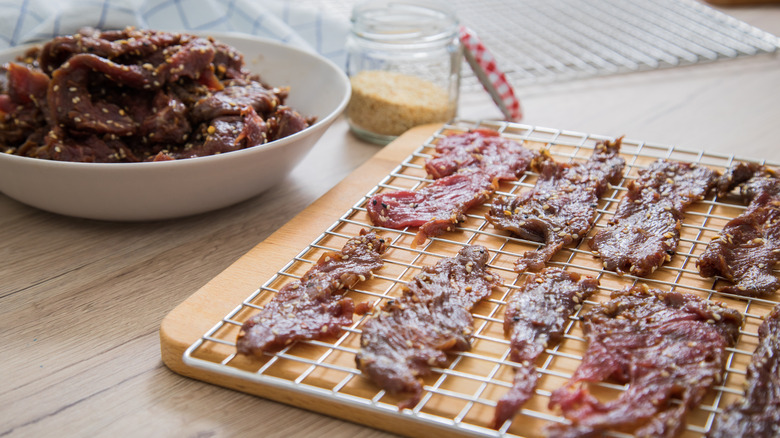The Best Type Of Meat To Use For Jerky
Jerky's been around for a long time. Before refrigeration, cured and dried meats were the way to go (via Britannica) — and they remain practical whether you're riding a horse through the desert or on a long car trip with friends. The meat-based category is among the fastest-growing snack sectors — projected to hit a meaty $21.3 billion by 2032, according to GlobeNewswire. With more and more people striving to eat well, jerky is actually one of the healthier snack choices, containing high amounts of protein, zinc, and vitamin B12 and low amounts of fat and carbs (per Healthline).
But say you want to make your own jerky. It's not as difficult as it seems — and you'll wind up with a seriously delicious product that costs you tons less than the small, expensive bags that seem to be everywhere nowadays. There are plenty of things to consider when making jerky at home, including the ingredients for the marinade, the drying method, and how to ensure you won't gobble up the finished product within a day (speaking from experience). But what's the best type of meat to use for jerky? We'll break it down for you.
Lean into it
In the art of jerky-making, the idea is to remove as much moisture from the meat as possible. This is the point of dehydration (per Britannica), which slows down the spoilage process enough to make jerky shelf-stable. Therefore, you want lean cuts of meat without intramuscular fat or marbling (via MasterClass). Fat is moist and will go bad down the line, defeating the purpose of the whole endeavor.
For beef jerky, anything from the hindquarter is most suitable: we're talking loin, round, and flank cuts which are user and budget-friendly (per Beef. It's What's For Dinner). Remember, these are muscles that move often, and they can be tough, so slice your jerky against the grain (per MasterClass) and don't go too thin, or it will become crunchy and brittle. Avoid cutting it too thick because it will dry inconsistently. Some jerky is made with flank steak, like in Alton Brown's recipe (via Food Network), but it's on the pricey side and requires more trimming. You can certainly use forequarter cuts, but there's much more connective tissue to deal with during preparation.
Don't stop at beef
Venison is also very popular in jerky-making, and if you hunt or know a hunter, you'll have a free supply. If not, you can use farm-raised venison (via D'Artagnan). It's naturally leaner and higher in protein and nutrients than beef — and the same goes for bison, per Healthline. Many kinds of lean meat can be jerky-fied, according to FoodPreserving.org. Opt for top-quality meat from your local butcher or a grocery store with a meat counter when making jerky.
Regardless of the cut or type of meat used, making jerky is simple. First, trim and slice your meat, then marinate it. A blend of soy sauce, Worcestershire sauce, brown sugar, and spices is common, but you can experiment by adding chili pepper and even fruit juice or soda (per Yummly). Marinate for a few hours or up to a week or more. The longer you marinate, the more the ingredients' flavors soak in, contributing to flavor and tenderness. Then, dry the meat on trays in a dehydrator or in your oven (via Food Network). Make sure you check and rotate the meat slices, so they dry out evenly. The final product is somewhat up to personal preference; some people like the stringy, chewy cowboy-style stuff, while others prefer a more tender bite. Either way, making homemade jerky is a rewarding, money-saving process — the hardest part will be trying not to eat it all before you've started your next batch.


